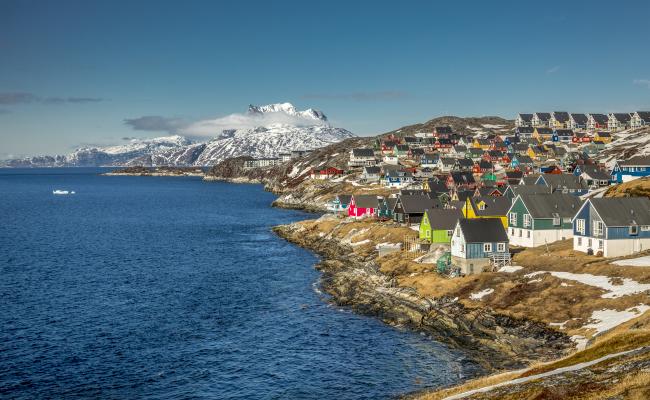Vaccination Rates Make Vulnerability Vary, Says Project Lead of Coronavirus Observatory
Dr Dwayne Ryan Menezes is the Founder and Managing Director of Polar Research and Policy Initiative. (Archive photo from the Arctic Circle Assemby 2021 in Reykjavik: Trine Jonassen)
Dr. Dwayne Ryan Menezes and Max Daniels from Polar Research and Policy Initiative are leading the project on tracking the Coronavirus in the Arctic and the Antarctic.
In an interview with High North News, Dr. Menezes says he believes it is of outmost importance to have and maintain consistent regional coverage of the pandemic. The observatory can be accessed here.
The states covered include the US (Alaska), Canada (Yukon, Northwest Territories, and Nunavut), Greenland, Iceland, Faroe Islands, Denmark, Norway, Sweden, Finland, and Russia.
"The Observatory is intended to serve as an efficient one-stop-shop for all the latest figures about the pandemic, as well as the evolving government measures being introduced in each state", says Dr. Menezes
Launching the Coronavirus Observatory
Dr. Menezes and his team launched the Coronavirus Observatory in March 2020, with a view to tracking the spread of, and responses to, the Covid-19 pandemic across the Arctic and the Antarctic.
"We figured it would be dreadfully tedious for a person to visit each of the government websites and newspapers for every national and subnational entity in Arctic and Nordic states to figure out the latest case counts or travel restrictions for the region as a whole - or if one had to cross from one to the next for any reason", Dr. Menezes says and continues:
"The team at Polar Research and Policy Initiative monitors the situation regularly and updates the report on a weekly basis. When we started the project, we had no idea how long the pandemic would last. We assigned a two-member team to manage the project and carried it out on a pro bono basis".
"We have been running the project now for 22 months, still entirely on a pro bono basis, but we have had to recruit a new five-member team to manage it. Each team member serves as the lead for two states, monitoring all developments therein on an ongoing basis", he says and adds:
"Should we wish for the Arctic to be seen and treated as one region globally, we believe it is of utmost importance to have and maintain such consistent regional coverage - and compilation of news and statistics - even in times of crisis or especially in times of crisis, partly to prevent fragmentation in perception and in practice, and partly to provide constantly a solid basis for ongoing regional cooperation".
It is important to consider vaccination rates not just at the national and provincial levels, but also at the local community level
Most vulnerable
Which part of the Arctic is most vulnerable to the pandemic?
"When it comes to thinking about parts of the Arctic most vulnerable to the pandemic, it is important to consider vaccination rates not just at the national and provincial levels, but also at the local community level. In the US, while the new Omicron variant has triggered a surge in the number of cases in New York, the number of confirmed cases and hospitalizations has been lower in Alaska in December 2021 than during the last surge the state witnessed in autumn due to the Delta variant", says Dr. Menezes, and adds:
"According to the Centers for Disease Control and Prevention, as of 20 December 2021, Alaska’s new case rate over a 7-day period was 36th in the US, with the death rate third lowest in the US. Yet, as the Omicron variant looms, Alaska’s top epidemiologist has expressed concern that Alaska’s vulnerability to a surge is above average compared to other US states and has encouraged Alaskans to have their primary vaccination series and then the booster shots".
"Alaska’s overall vaccination rate is still lower than that in other states, though it has higher than average rates of booster shots administered. Denmark, Norway, Finland, and Iceland fear the number of confirmed Covid-19 cases is soaring rapidly, with numbers of infections and hospital admissions reaching their peak since the start of the pandemic, and have imposed stricter measures. While the surge has been driven mainly by the Delta variant, Omicron is expected to surpass Delta as the dominant variant in the coming days, starting with national capitals, such as Copenhagen and Oslo, but then nationwide as well."
What developments do you see in the spread of Covid-19 in the Arctic?
“In Canada, new restrictions are coming into effect in large swathes of the country as the fifth wave of Covid-19 spreads across the country. Nova Scotia recently reported a single-day high of new cases. Quebec is experiencing a recent spike in the number of severe cases, and the City of Montreal has already declared a local state of emergency. While the rate of hospitalizations has remained stable in Ontario, it is also preparing for higher rates of hospitalization in the coming weeks. Nunavut has recently reported two additional cases in Pangnirtung”, says Dr. Menezes, and continues:
“Even in November 2020, Nunavut was the only place in Canada and North America not to have a single case of Covid-19, but that has all changed since. By 21 December 2021, Nunavut has had 676 confirmed cases, including four deaths. Elsewhere in the Canadian North, the Northwest Territories has had 2,083 confirmed cases (12 active), including 12 deaths, by 21 December 2021, while Yukon has had 1,652 confirmed cases (49 active), including 14 deaths, by the same date.”
Alaska’s top epidemiologist has expressed concern that Alaska’s vulnerability to a surge is above average compared to other US states
Denmark and Norway
Denmark and Norway, in particular, are concerned that the combined pressure imposed by both variants will saturate the national health systems.
"In Denmark, data shows that doubly-vaccinated individuals are just as vulnerable to omicron infection as those that are unvaccinated. Even though the booster shot offers greater protection, three of every four Danes have yet to receive a third dose", Dr. Menezes says.
Sweden
According to Dr. Menezes, in Sweden, while the number of hospitalizations and intensive care cases is still among the lowest per capita in Europe (still 43% of peak), infections have started to spread at a much faster rate, with the peak expected to hit in mid-January, with highest daily numbers since the start of the pandemic.
"Russia recorded its highest daily averages of new infections and deaths in late-October 2021 and early November, with the number of cases falling since and is currently at around 70% of the peak. The number of Omicron cases, however, has grown from the first confirmed cases to be reported around 6 December to 41 cases by 21 December, and the country is preparing for a winter Covid wave", Dr. Menezes says.
Different responses
How do the eight Arctic countries differ in their response to the pandemic?
“In March 2020, as the world moved rapidly into a new age of lockdowns, restrictions (especially on travel and meetings), tests, and eventually vaccines, we recognized how difficult it would be to keep track of the evolving measures in each country even when we planned our own lives and travels. One advantage of being headquartered in London is that we can usually fly to the national and regional capitals of all Arctic states with considerable ease", Dr. Menezes says and continues:
"A key reason why we, at Polar Research and Policy Initiative, have our finger on the pulse of all the latest developments in the Arctic is that we spend as much time with our friends, colleagues, and wider communities resident in the Arctic, as we do at our home base in London, as well as our regional bases in the US, Canada, Australia, India, and the Middle East. It has allowed Polar Research and Policy Initiative to become probably the most effective and reliable year-round connector of people, cross-pollinator of ideas, and driver of regional and international cooperation in the Arctic, outside of annual conferences and regional institutions", the polar scientist says and adds:
“However, in the new pandemic world, we no longer reaped those advantages that London usually offered: we were neither able to leave London nor convene meaningfully within it - or indeed elsewhere. The situation in the Arctic and Nordic regions was no different, and we found ourselves unable to convene or attend policy dialogues and conferences in person, or set up meetings, or fulfill in-person speaking engagements".
We have been running the project now for 22 months, still entirely on a pro bono basis
The greatest challenge
What was the greatest challenge in mapping the pandemic in the Arctic?
"The greatest challenge was simply making sense of the extreme heterogeneity that had been imposed in the wink of an eye in regions that had moved so substantially over recent decades towards greater consistency and uniformity in internal policies concerning travel", Dr. Dwayne says and continues:
"While the US soon shut its borders to all international travelers from Europe, even the Schengen Zone, which has done much to aid free movement in Europe through the establishment of a single jurisdiction for international travel and the abolition of border control at the mutual borders of member states, now seemed like a complex maze of challenges and obstacles one had to monitor and overcome in order to jump from one square of the board game to the next".
“Even in the Nordic region, generally characterized by perhaps the highest levels of uniformity and consistency in regional policies, Sweden appeared to walk down a very different path than its Fennoscandian neighbors, being much slower and softer in its adoption of lockdowns. It was as if we had gone to bed one night and woken up the next morning in a new dystopian drama or reality television game show better suited for Netflix".
"If we, as policy analysts whose job it is to monitor such changes, found it so difficult to keep track of evolving regulations and expectations, we wondered how much more difficult and inconvenient it would be for everyone else who may need to travel to go back home or reunite with loved ones, or nurse a relative, or meet a friend, or perform a job, or engage in business activity. That is why we decided to develop a solution that would at least make it more convenient for people who had to travel to or operate in Arctic and Nordic states and navigate the evolving policy landscape when it came to travel and meetings", Dr. Menezes says in closing.



